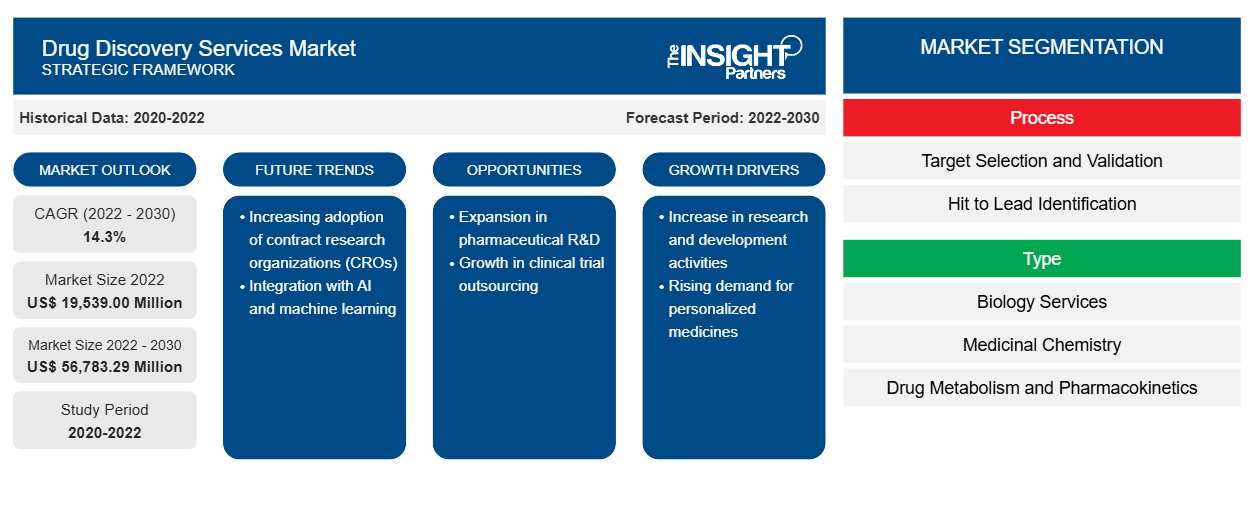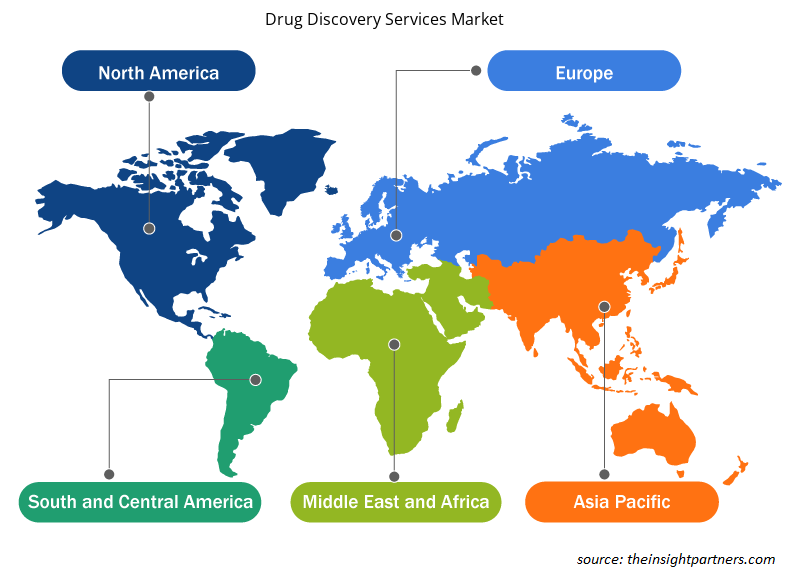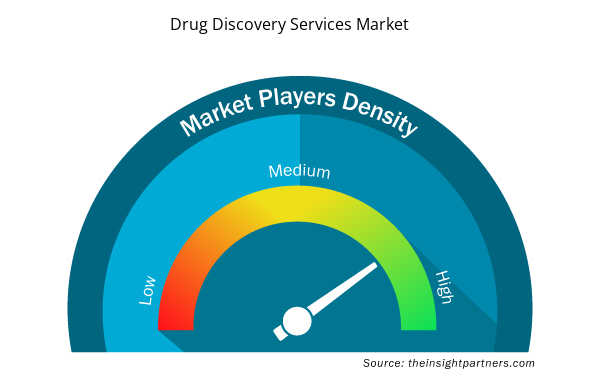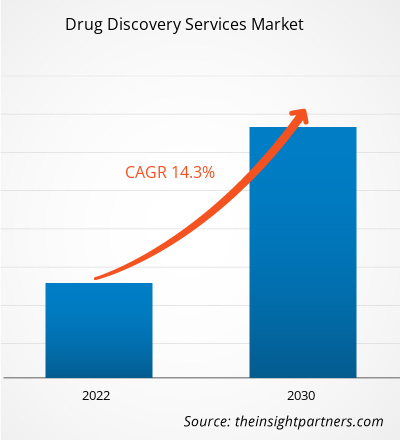[Research Report] The drug discovery services market size is projected to grow from US$ 19,539.00 million in 2022 to US$ 56,783.29 million by 2030; the market is anticipated to record a CAGR of 14.3% from 2022 to 2030.
Market Insights and Analyst View:
Drug discovery is the process of identifying or developing new medications to treat diseases and improve human health. It involves the identification of potential drug candidates in stages ranging from their synthesis to testing in laboratories and animal models, and evaluation in human trials. Drug discovery service providers offer specialized expertise and resources to support the drug discovery process. This can include medicinal chemistry, computational modeling, high-throughput screening, and preclinical testing services. These services are often provided by contract research organizations (CROs) or academic research institutions. Pharmaceutical companies and biotechnology firms opt for these services to accelerate drug discovery processes without compromising their efficiency.
Growth Drivers and Challenges:
The drug discovery services market is experiencing significant growth due to an ever-increasing demand for novel therapies across an array of therapeutic areas. The drug discovery process is complex and time-consuming, and its success is based on extensive research conducted to potential drug candidates as well as their testing and validation. As a result, pharmaceutical companies and research institutions increasingly rely on drug discovery service providers, which support their drug development efforts. These service providers offer target identification and validation, lead optimization, preclinical studies, and pharmacokinetic and toxicology testing, among other noteworthy services. Biotechnology and pharmaceutical companies are seeking to develop targeted treatments that can address the specific genetic and molecular characteristics of individual patients, leading to a more personalized approach to healthcare. This, the growing focus on precision medicine and personalized therapies further fuels the demand for drug discovery services.
Increasing R&D investments by pharmaceutical companies, and the availability of advanced technologies such as high-throughput screening, computational modeling, and artificial intelligence further benefit the drug discovery services market. These technologies enable more efficient and effective drug discovery processes, leading to a higher success rate in bringing new drugs to market. The process of discovering and developing new drugs is expensive, often requiring substantial investment in research, development, and clinical trials. The average cost of creating new medicines among the top 20 worldwide biopharmaceuticals examined in the Genetic Engineering & Biotechnology study increased by 15% ($298 million) to almost $2.3 billion last year.
The high failure rate of drug candidates in the later stages of clinical studies further adds to the overall cost of drug development. As a result, pharmaceutical and biotechnology companies are increasingly seeking cost-effective drug discovery services, which compels service providers to offer competitive pricing while maintaining high-quality standards. The high cost of drug molecules also impacts the affordability of new therapies for patients, especially in the case of rare diseases or niche therapeutic areas, which is a major area of challenge for both drug developers and healthcare systems amid the process of providing access to innovative treatments.
Customize This Report To Suit Your Requirement
You will get customization on any report - free of charge - including parts of this report, or country-level analysis, Excel Data pack, as well as avail great offers and discounts for start-ups & universities
Drug Discovery Services Market: Strategic Insights

- Get Top Key Market Trends of this report.This FREE sample will include data analysis, ranging from market trends to estimates and forecasts.
You will get customization on any report - free of charge - including parts of this report, or country-level analysis, Excel Data pack, as well as avail great offers and discounts for start-ups & universities
Drug Discovery Services Market: Strategic Insights

- Get Top Key Market Trends of this report.This FREE sample will include data analysis, ranging from market trends to estimates and forecasts.
Report Segmentation and Scope:
The drug discovery services market is segmented on the basis of process, type, molecule type, therapeutic area, and end user. Based on process, the market is segmented into target selection and validation, hit to lead identification, and others (assay development, screening, etc.). The drug discovery services market, by type, is segmented into biology services, medicinal chemistry drug metabolism, and pharmacokinetics. In terms of molecule type, the drug discovery services market is classified as biologics and small molecules. On the basis of therapeutic areas, the market is differentiated into cardiovascular diseases, oncology, neurology, diabetes, respiratory diseases, and others. By end user, the drug discovery services market is segmented into pharmaceutical and biotechnology companies, academic institutes, and others. Based on geography, the drug discovery services market is divided into North America (US, Canada, and Mexico), Europe (UK, Germany, France, Italy, Spain, and Rest of Europe), Asia Pacific (China, Japan, India, South Korea, Australia, and Rest of Asia Pacific), Middle East & Africa (UAE, Saudi Arabia, South Africa, and Rest of Middle East & Africa), and South & Central America (Brazil, Argentina, and Rest of South & Central America).
Segmental Analysis:
The small molecules segment held a larger revenue share of the drug discovery services market, based on molecule type. The market growth for small molecules is ascribed to the fact that they are simple to study, well-defined, and easy to characterize.
In 2022, the medicinal chemistry segment held the largest share of the drug discovery services market, by type. Medicinal chemistry finds extensive use in various areas of drug discovery, ranging from candidate delivery to preclinical studies.
On the basis of therapeutic area, the oncology segment dominated the drug discovery services market in 2022. The market growth for this segment is attributed to the rise in cancer-related drug discovery efforts worldwide. Oncology is an ever-growing market due to the rising incidence of various cancers in the general population. The International Agency for Research on Cancer estimated ~10 million cancer-related deaths and 19.3 million new cancer cases in 2020. The global number of new cancer cases is predicted to increase by 47% from 2020 to 2040. As a result, nearly 28.4 million new cancer cases are projected worldwide by 2040.
Drug Discovery Services Market Regional Insights
The regional trends and factors influencing the Drug Discovery Services Market throughout the forecast period have been thoroughly explained by the analysts at Insight Partners. This section also discusses Drug Discovery Services Market segments and geography across North America, Europe, Asia Pacific, Middle East and Africa, and South and Central America.

- Get the Regional Specific Data for Drug Discovery Services Market
Drug Discovery Services Market Report Scope
| Report Attribute | Details |
|---|---|
| Market size in 2022 | US$ 19,539.00 Million |
| Market Size by 2030 | US$ 56,783.29 Million |
| Global CAGR (2022 - 2030) | 14.3% |
| Historical Data | 2020-2022 |
| Forecast period | 2022-2030 |
| Segments Covered |
By Process
|
| Regions and Countries Covered | North America
|
| Market leaders and key company profiles |
Drug Discovery Services Market Players Density: Understanding Its Impact on Business Dynamics
The Drug Discovery Services Market is growing rapidly, driven by increasing end-user demand due to factors such as evolving consumer preferences, technological advancements, and greater awareness of the product's benefits. As demand rises, businesses are expanding their offerings, innovating to meet consumer needs, and capitalizing on emerging trends, which further fuels market growth.
Market players density refers to the distribution of firms or companies operating within a particular market or industry. It indicates how many competitors (market players) are present in a given market space relative to its size or total market value.
Major Companies operating in the Drug Discovery Services Market are:
- Agilent Technologies Ubiquigent
- Abbott Laboratories Inc.
- Advinus Therapeutics Albany Molecular Research Inc.
- Aurigene
- Bayer AG
Disclaimer: The companies listed above are not ranked in any particular order.

- Get the Drug Discovery Services Market top key players overview
Regional Analysis:
Based on geography, the drug discovery services market is primarily segmented into North America, Europe, Asia Pacific, the Middle East & Africa, and South & Central America. North America is the most significant contributor to the growth of the global market. Market growth in this region is attributed to investments made by drug development companies, large grants offered by the US government, the robust presence of major drug development companies, a well-established healthcare infrastructure, and an increase in chronic disease incidences.
The American Cancer Society's "Cancer Facts & Figures 2022" estimated ~1,918,030 new cancer cases and 609,360 cancer-related deaths in the US by the end of 2022. Given the high rate of cancer in this area, research activities to innovate cancer drugs are likely to flourish in the US in the coming years. CytoReason and Pfizer signed a multi-year cooperation in September 2022. According to this deal, Pfizer can use CytoReason's artificial intelligence technology for the development of medicines. The use of AI technology in drug discovery by major companies in the US is anticipated to propel the expansion of the drug discovery services market.
Asia Pacific is expected to register the highest CAGR in the drug discovery services market during 2022–2030. The market growth in this region is ascribed to increasing investments in research & development activities in countries such as China, India, Japan, and South Korea, which are emerging as key pharmaceutical and biotechnology hubs. Furthermore, the presence of a large pool of skilled researchers and scientists, along with lower operating costs compared to Western countries, makes Asia Pacific an attractive destination for outsourcing drug discovery services. The increasing prevalence of chronic diseases and the need for innovative medications to address unmet medical needs are creating demand for new medications, thereby benefiting the drug discovery services market growth in the region.
Competitive Landscape and Key Companies:
Agilent Technologies Ubiquigent, Abbott Laboratories Inc., Advinus Therapeutics Albany Molecular Research Inc., Aurigene, Bayer AG, AstraZeneca PLC, Charles River Laboratories International, Covance, and ChemBridge Corporation are a few prominent players operating in the drug discovery services market. These companies focus on expanding service offerings to meet the growing consumer demand worldwide. Their global presence allows them to serve a large set of customers, subsequently allowing them to expand their market share.
- Historical Analysis (2 Years), Base Year, Forecast (7 Years) with CAGR
- PEST and SWOT Analysis
- Market Size Value / Volume - Global, Regional, Country
- Industry and Competitive Landscape
- Excel Dataset


- Neurovascular Devices Market
- Advanced Planning and Scheduling Software Market
- Single Pair Ethernet Market
- Customer Care BPO Market
- Virtual Production Market
- Parking Management Market
- Medical Second Opinion Market
- Sexual Wellness Market
- Electronic Signature Software Market
- Semiconductor Metrology and Inspection Market

Report Coverage
Revenue forecast, Company Analysis, Industry landscape, Growth factors, and Trends

Segment Covered
Process, Type, Molecule Type, Therapeutic Area, End User, and Geography

Regional Scope
North America, Europe, Asia Pacific, Middle East & Africa, South & Central America

Country Scope
This text is related
to country scope.
Frequently Asked Questions
What factors drive the drug discovery services market?
Increasing demand for novel therapies across a wide range of therapeutic areas, and rising R&D expenditure in the pharmaceutical and biotechnology industries are driving the drug discovery services market. However, the high cost of drug discoveries hinders the drug discovery services market growth.
What was the estimated drug discovery services market size in 2022?
The drug discovery services market was valued at US$ 19,539.00 million in 2022.
What is drug discovery services?
Drug discovery is the process of identifying and characterizing molecules with the potential to safely modulate disease, with a goal to bring medicines that can improve the lives of patients. It is a lengthy and resource intensive process, that requires close cooperation across multiple disciplines.
Who are the major players in the drug discovery services market ?
The drug discovery services market has major market players, including Abbott Laboratories Inc., Agilent Technologies Ubiquigent, Albany Molecular Research Inc., Advinus Therapeutics, AstraZeneca PLC, Bayer AG, Aurigene, Charles River Laboratories International, ChemBridge Corporation, and Covance.
What are the growth estimates for the drug discovery services market till 2030?
The drug discovery services market is expected to be valued at US$ 56,783.29 million in 2030.
Which type segment dominates the drug discovery services market?
Based on molecule type, the small molecules segment held the most revenue share in the worldwide drug discovery services market. Its rise was encouraged by the tiny molecules' simple, well-defined, and easy-to-characterized nature. The public is more in demand for and considerably more productive with small molecule pharmaceuticals. Because they are small molecules, they small molecules can affect cells readily and can be used to treat patients effectively. This market has grown as a result of a growing understanding of the advantages of small-molecule medications.
Which application type segment dominates the drug discovery services market?
In 2022, the medicinal chemistry segment held the largest market share in the drug discovery services market based on type. Medicinal chemistry finds extensive use in drug discovery services, ranging from candidate delivery to preclinical studies. Consequently, this segment's prominence can be attributed to its significance. Furthermore, the biopharmaceutical businesses' increased outsourcing is anticipated to fuel this segment's expansion.
Which therapeutic area segment dominates the drug discovery services market?
In 2022, on the basis of therapeutic area, the global market for drug discovery services was dominated by the oncology segment, owing to increase in cancer-related medication discovery efforts. The oncology market has grown as a result of the rising incidence of various cancers in the general population. The International Agency for Research on Cancer estimates that there will be about 10 million cancer-related deaths and 19.3 million new cancer cases in 2020. The global number of new cancer cases is predicted to increase by 47% between 2020 and 2040. As a result, it is projected that there will be about 28.4 million new instances of cancer worldwide in 2040.
Trends and growth analysis reports related to Life Sciences : READ MORE..
The List of Companies - Drug Discovery Services Market
- Agilent Technologies Ubiquigent
- Abbott Laboratories Inc.
- Advinus Therapeutics Albany Molecular Research Inc.
- Aurigene
- Bayer AG
- AstraZeneca PLC
- Charles River Laboratories International
- Covance
- ChemBridge Corporation

 Get Free Sample For
Get Free Sample For